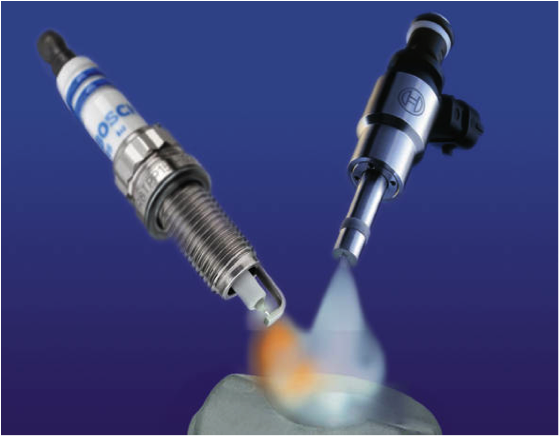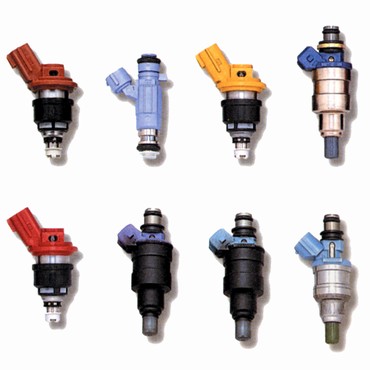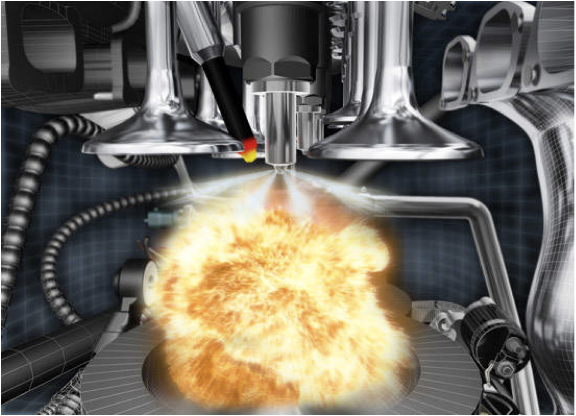| What's Hot! | Products/ Tools | EFI Tuning | Basic Tuning | Advanced Tuning | Chassis Tuning | Advertise with us |
Fuel Injectors Part 2.
Peak and Hold Vs. Saturated
Contributed By: Joe A.


History
Multiport injection (MPI) is a system used for efficiently mixing air and fuel used in an internal combustion engine. This system was designed to replace carburetors, which were the predominant method to mix and measure fuel before fuel injection. Carburetors worked by taking advantage of one of the engines cycles. Basically the engine creates a vacuum in the cylinders, and when that happened, the carburetor was there to give out the perfect balance of gas and air into the engine. While this was effective, it lacked the precision to give better mileage and lower emissions.
In 1925, Swedish engineer Jonas Hesselman came up with this solution. He invented the Hesselman engine, which was the first use of direct gasoline injection. Hesselman engines use the ultra-lean principle; fuel is injected toward the end of the compression stroke, then ignited with a spark plug. They are often started on gasoline and then switched to diesel or kerosene. Fuel injection was in widespread commercial use in diesel engines by the mid-1920s. Because of its greater immunity to wildly changing g-forces on the engine, the concept was adapted for use in gasoline-powered aircraft during World War II.
One of the first commercial gasoline injection systems was developed by Bosch and introduced in 1952 on the Goliath GP700 and Gutbrod Superior 600. Bosh designs are still widely used in most vehicles today.
Basic Function
The multiport injection system, which is located on each cylinder, works in a simple way. As with carburetors, the engine still creates suction. When an injector is energized by the Electronic Control Unit (ECU), its internal parts physically move to let the pressurized fuel flow through. The amount of fuel delivered is controlled by how long the injector is energized by the ECU and its driver circuit. This time is usually specified in milliseconds (ms). An injector is "pulsed" -open for short periods of time at idle, and held open longer as RPM and the engine's airflow increases, which requires an equal increase in fuel flow. Most fuel injectors are found in the intake manifold where it is injected into the intake stream and then flows into the cylinder. Currently cars are taking advantage of what is called “ Direct Injection “ where the fuel is directly injected into the cylinder instead of being injected into the intake manifold. Want to know more? Read this article on Direct Injection.

Peak and Hold Vs. Saturated Comparison
Saturated
There are two types of drivers in MPI systems. One is the saturated driver, and one is the peak and hold. First, you have to match the injector's operating parameters to your ECU. Most domestic production Electronic Fuel Injection (EFI) systems use an ECU with 12 volt Saturated Circuit drivers. These systems are very inexpensive, simple, and reliable. This type of driver works by supplying 12 volts to the injectors and the ECU turns it on and off to establish a fuel injector pulse. In general, if an injector has a high resistance specification (12-16 ohms) the ECU uses a 12 volt saturated circuit driver to control it. This means that the current flow in the driver and injector circuit stays low keeping the components cool for long life. The downside to a Saturated Circuit driver is that it has a slower response time (opening and closing time) than a peak and hold type. This slower time can somewhat decrease the usable operating range of the injector energized by this driver. An injector operating on a saturated circuit driver typically has a reaction time of 2 milliseconds while a peak and hold driver typically responds in 1.5 ms.
Peak and Hold
The next kind of driver is called Peak and Hold Drivers and Injectors. These types of injectors and drivers may also be called current sensing or current limiting. Peak and Hold injectors are usually used in aftermarket high performance systems. Because they are more expensive and complex than saturated circuit drivers, they are not generally used with domestic production ECUs. Most high flow injectors are low resistance (2-5 ohms) and use a peak and hold driver to activate them. With this type of driver, 12 volts is still delivered to the injector, but because of its low resistance, the current in the driver circuit is high. The substantial increase in current flow is something a saturated injector cannot handle. The Peak current quickly opens the injector while the lower Hold current rating is used to keep it open for the duration of the ECU command. Because these injectors have larger physical parts and often work against high fuel pressure, they require an extra “kick” from the higher current to keep the opening and closing time of the injector stable at the higher fuel flow rate.
Performance Fuel Injectors.....find some for your application today ----->
ATTENTION READER:
If you enjoyed the information and article you just read be sure to check out our newly released book with even more exciting photo's and information:How to Turbocharge and Tune your Engine

Want to know more about your particular Make and Model vehicle? All of these vehicles are covered in the tech, maintenance and repair articles found above. Enginebasics is the wiki or wikipedia of car part, repair, how to and tuning information. Let us be the class 101 for your automotive learning.
| Ford | General Motors GM | Pontiac | Jaguar | Land Rover | Nissan |
| Toyota | Honda | Lexus | Acura | Lotus | Scion |
| Infinity | BMW | Mercedes | Mitsubishi | Ferrari | Maserati |
| Lamborghini | Volks Wagen VW | Saab | Audi | Hyundai | Kia |
| Subaru | Mazda | Chevy | Volvo | Caddilac | Dodge |
| Chrylser | Daewoo | Porsche | Mercury | Freightliner | MG |
Individual Models
| Ford Mustang | Mitsubishi Eclipse | Mitsubishi Evo | Subaru WRX / STI | Dodge Viper | Chevrolet Corvette |
| Nissan Skyline | Honda S2000 | Nissan 350z | Toyota Supra | Chevy Camaro | Lotus Elise Exige |
| Honda Civic | VW Golf | Dodge SRT-4 | Eagle Talon | Acura Integra | BMW M3 |
| Nissan 240sx | Porsche 911 | Acura NSX | Honda Accord | Toyota Camry | Toyota MR2 |
| VW R32 | Dodge Truck | Mazda Rx7 | VW Jetta | Sand Buggy | Nissan Sentra |
For the latest Automotive news and stories visit the websites below |
Our feature Build: An AWD V6 Civic




